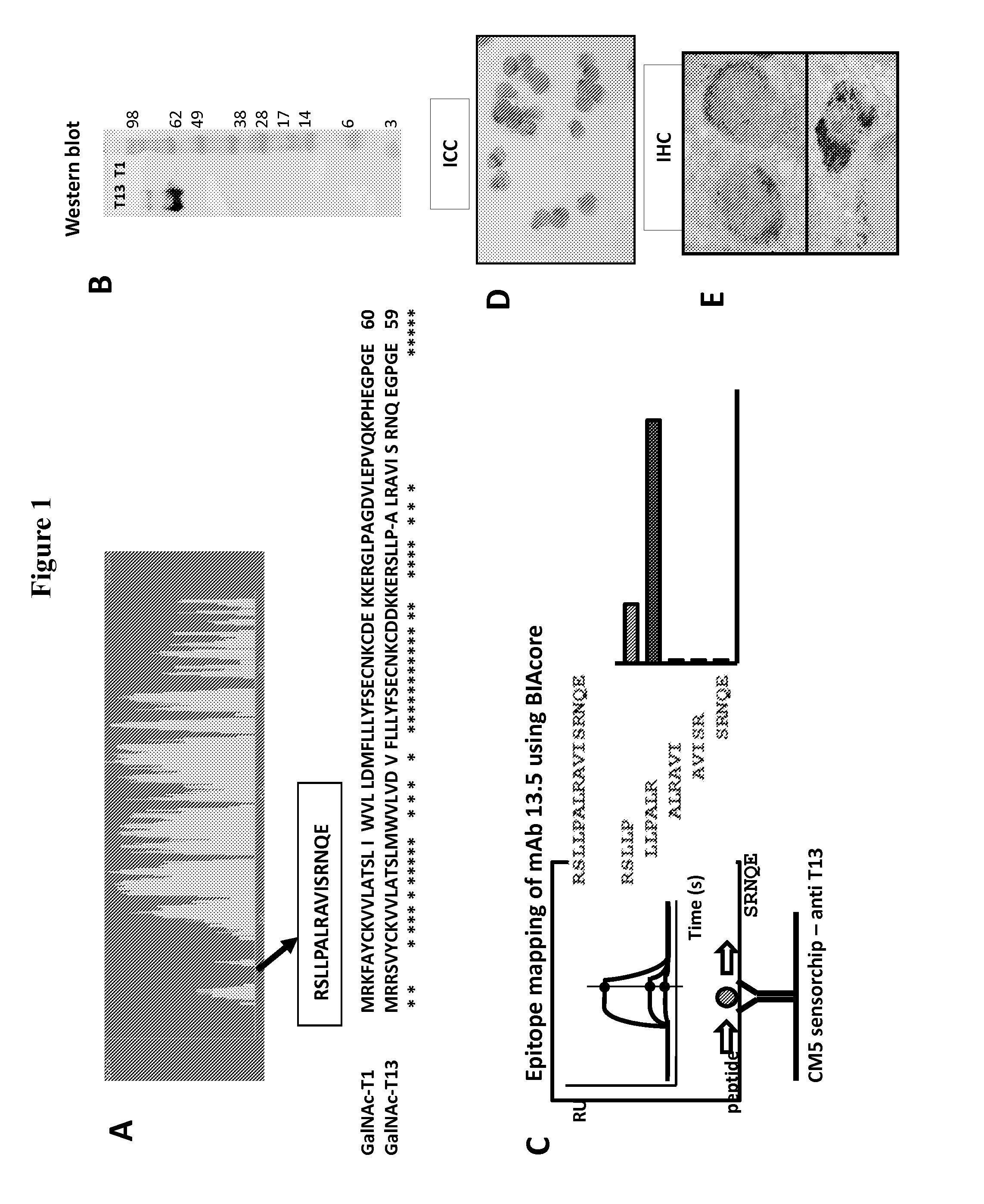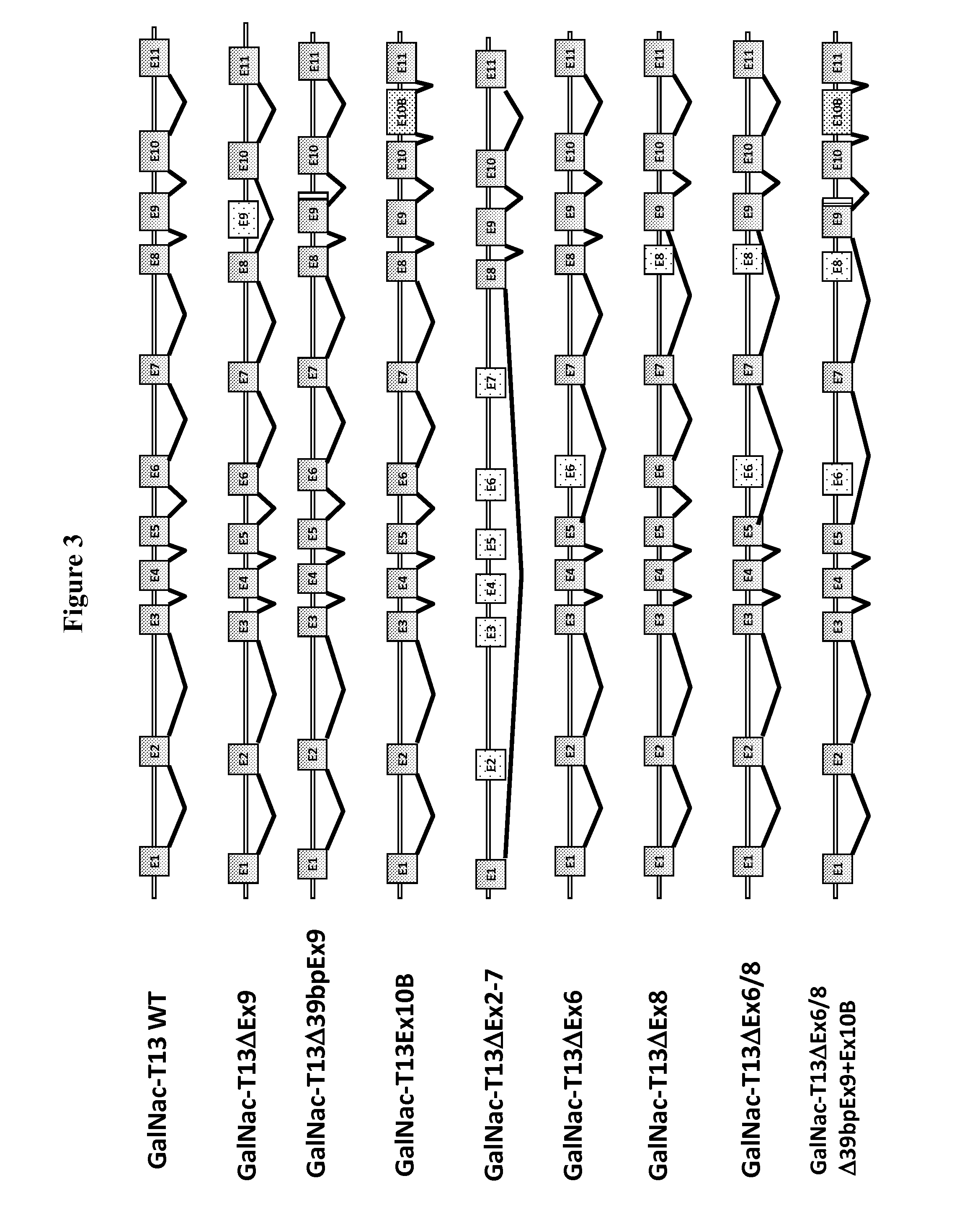Novel method to detect resistance to chemotherapy in patients with lung cancer
a technology of oglycosylation pathway and chemotherapy, which is applied in the field of novel methods to detect resistance to chemotherapy in patients with lung cancer, can solve the problems that most cancer patients treated with chemotherapy will suffer severe toxicity, and achieve the effect of reducing increasing the likelihood of chemotherapy resistan
- Summary
- Abstract
- Description
- Claims
- Application Information
AI Technical Summary
Benefits of technology
Problems solved by technology
Method used
Image
Examples
example 1
Cell Lines
[0089]Human lung cancer cell lines representing different histological types, stages and conditions of disease (SK-MES-1, A549, NCI-H1703, NCI-H838, NCI-H1755, NCI-H526, NCI-H1650, NCI-H1975, H69AR and NL-20) were purchased from ATCC and in vitro cultured according with provider's instructions.
Production of Anti-GalNAc-T13 Monoclonal Antibody (T13.5 Hybridoma Production Protocol)
Immunization
[0090]A synthetic peptide of GalNAc-T13 was selected in the region which displays very high variability among GalNAc-Ts family members (RSLLPALRAVISRNQE, accession number BAC54545) (Biosynthesis). Four Balb / c female mice of 8 weeks of age from the Division of Veterinary Laboratories (DI.LA.VE., Montevideo, Uruguay) were used.
[0091]Mice were immunized three times at 2 week intervals (d0, i.p. and d14, d21, s.c.). The immunization mixture contained 50% v / v 100 μg of the synthetic peptide carried by KLH in PBS and Freund's adjuvant (complete for the first immunization a...
example 2
Generation of a Monoclonal Antibody Specific for GalNAc-T13 Useful for Immunohistochemical Studies in Paraffin Embedded Tissues
[0104]Considering that GalNAc-T13 displays 84% homology compared with GalNAc-T1 we immunized mice with a KLH-conjugated specific motif (RSLLPALRAVISRNQE) of GalNAc-T13, without any homology with GalNAc-T1 sequence (FIG. 1A). Selection of specific hybridomas was performed by ELISA, screening against BSA-conjugated GalNAc-T13 peptide. One of the mAbs, T13.5, strongly reactive against the synthetic peptide, was used for further characterization. We evaluated the mAb T13.5 reactivity in Western blot using GalNAc-T1 and -T13 expressed in baculovirus. We found that the antibody reacts with GalNAc-T13 but not with GalNAc-T1 (FIG. 1B), confirming the specificity of this antibody for GalNAc-T13 and that it binds to denatured forms of the protein. To determine which amino acid residues are crucial for mAb T13.5 binding we mapped the epitope using overlapping peptides ...
example 3
GalNAc-T13 is Expressed in Human Lung Cancer Cells
[0105]Seventy two lung cancer patients presenting locally advanced disease received neoadjuvant therapy prior surgery. Patients were treated with one of carboplatin and paclitaxel, or carboplatin and docetaxel, or carboplatin and gemcitabine, or carboplatin and pemetrexed, or carboplatin and etoposid, or cisplatin and docetaxel, or cisplatin and etoposide, or cisplatin and gemcitabine, or paclitaxel and cetuximab.
[0106]It was reported that GalNAc-T13 is a glycosyltransferase specifically expressed in neuronal tissue (Zhang et al., 2003). Here, evaluating a panel of human lung cancer cell lines by RT-PCR, we found the mRNA coding GalNAc-T13 in A549, NCI-H1703, NCI-H1755, NCI-H526, NCI-H1650, H69AR and NL-20 cell lines (FIG. 2A). In contrast, the RT-PCR analysis was negative in SK-MES-1, NCI-H838 and NCI-H1975 cell lines. We confirm at protein level the expression of GalNAc-T13 in human lung cancer cells using immunofluorescence micros...
PUM
| Property | Measurement | Unit |
|---|---|---|
| volume | aaaaa | aaaaa |
| pH | aaaaa | aaaaa |
| pH | aaaaa | aaaaa |
Abstract
Description
Claims
Application Information
 Login to View More
Login to View More - R&D
- Intellectual Property
- Life Sciences
- Materials
- Tech Scout
- Unparalleled Data Quality
- Higher Quality Content
- 60% Fewer Hallucinations
Browse by: Latest US Patents, China's latest patents, Technical Efficacy Thesaurus, Application Domain, Technology Topic, Popular Technical Reports.
© 2025 PatSnap. All rights reserved.Legal|Privacy policy|Modern Slavery Act Transparency Statement|Sitemap|About US| Contact US: help@patsnap.com



